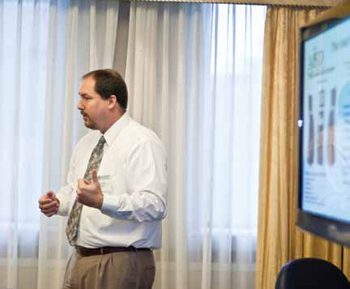The Infrastructure

Forget about the acronyms (BYOT) and the catchphrases (oneto- one). Today’s school CIO has to manage every device and platform, whether student or school owned, while ensuring online access both on campus and off.
[The scenario]
Mr. Smith’s seventh-grade classroom is abuzz with activity. He stands hunched over one group that is huddled with their district-provided Linux-based netbooks, researching the Library of Congress online archives. Several students fire off backchannel texts with their personal iPhones and Droids to friends from another district whose work they found while surfing the Web. Their research is then posted to the class Facebook page (with full attribution, of course!). Later that day the group is at the local coffee shop with iPad 2s, recording podcasts that will be uploaded wirelessly via the school network to YouTube. All this occurs under the purview and discretion of district bandwidth and acceptable-use policies.
[Executive Summary]
Kyle Berger, Executive Director of Technology, Alvarado ISD, Texas One of the most essential things any school CIO must do is ensure that students have the tools to improve their digital literacy and control their digital lives. This is easier said than done. Besides the technical complexities, district executives have to manage students’ behavior and the greater school community’s acceptance of these new realities, which include providing access throughout the entire district’s geography.

How to do that? Participants in the summit’s one-to-one working group shared strategies they are already employing in their districts. These included making sure the adoption of new technologies is gradual and ubiquitous; engaging the public—this includes parents, board, faculty, and students—in the process; and providing continuous professional learning along the way. Jim Klein at Saugus Union Schools in California uses open-source code to manage multiple platforms. Debbie Rice at Alabama’s Auburn City Schools detailed how the district distributed laptops to teachers and began professional development six to eight months before they gave them to students. Six years later, teachers still meet regularly. The Alvarado, Texas, school district began its device program with intermediate grades. Executive Director of Technology Kyle Berger explained that it improved administrators’ ability to track results, which can affect future testing and learning. Even more radical: Alvarado hosts a wide-area network using Wi-Fi kiosks that are spread throughout the district. However a district approaches the issue, all agreed that it is no longer a question of if but a question of when. And the answer? Now.
What They Said
Tools and ideas to transform education. Sign up below.
“We let them bring the technology they are comfortable with. Let them have a sense of ownership. They have them in their pockets anyway.”
—Kyle Berger, executive director of technology, Alvarado (Texas) ISD
“We use the 80–20 rule: We spend 80 percent of the time planning the implementation, 20 percent actually doing it.”
—Debbie Rice, director of technology, Auburn City Schools, AL
“We’ve been asking the wrong questions. I think we should be asking questions such as ‘What does it mean to be well educated in the 21st century?’ How many people have sat down and actually had that conversation in their district?”
—Jim Klein, director information services and technology, Saugus Union Schools, CA
Jim Klein Director IS & IT,

Saugus Union School District, CA
Carl Hooker, Director of Instructional Technology, Eanes Independent School District, Texas
“We focused on four questions: What is our pedagogy? What is our expectation of students? What are the methods for delivering resources? And finally, what tool do we use to tie these all together?”
—Rick Cave, director of technology, West Windsor–Plainsboro School District, NJ
“How do we make ourselves more relevant as a school district? Make sure kids have a flexible learning style where each has their own individual learning path. Without technology, they wouldn’t be able to do that.”
—Carl Hooker, director of instructional technology,, Eanes ISD, Texas
Working Group Take-Aways
Realizing the BYO Vision
Key Concepts:
• The tech department no longer owns services for consumer devices that come into the school.
• Students/teachers must take responsibility for the role tech plays in their work.
Responsible/Acceptable Use Procedure Changes for BYO
• Students are permitted to connect to the district network via the secure wireless connection provided by the school system, but all access must be in accordance with this Acceptable Use Policy.
• Students are NOT permitted to use their own computing devices to access the Internet via personal Wi-Fi accounts or by any manner other than connecting through the secure wireless connection provided by the school system.
SOURCE: Bailey Mitchell, Forsyth County Schools
Find more take-aways from the School CIO summit in the program vault under schoolcio.com (click on “Events”).
[Participants]
Guy Ballard
CTO
Niles Township High School District 219, IL
Cristen Herring
Assistant Superintendent
Auburn City Schools, AL
Thuan Nguyen
CIO
Kent School District, WA
Jean Tower
Director of Technology
Northborough-Southborough, MA
Kyle Berger
Executive Director of Technology
Alvarado ISD, Texas
Rick Cave
Director of Technology
West Windsor-Plainsboro School District, NJ
Carl Hooker
Director of Instructional Technology
Eanes Independent School District, Texas
Jim Klein
Director IS & TS
Saugus Union School District, CA
Jeff Mao
Learning Technology Policy Director
State of Maine, Department of Education
Debbie Rice
Director of Technology
Auburn City Schools, AL
